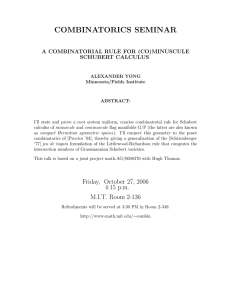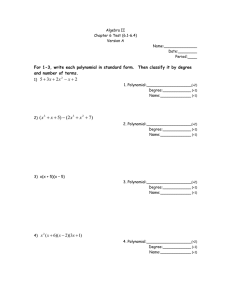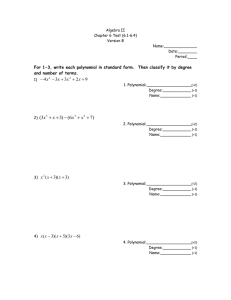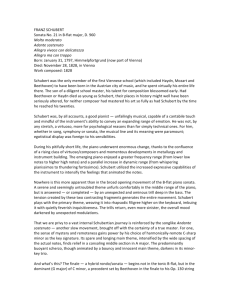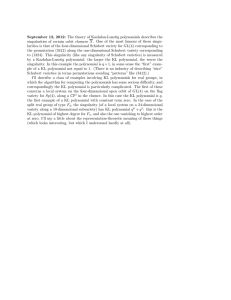Multiplicities of Points on Schubert Varieties in Grassmannians
advertisement
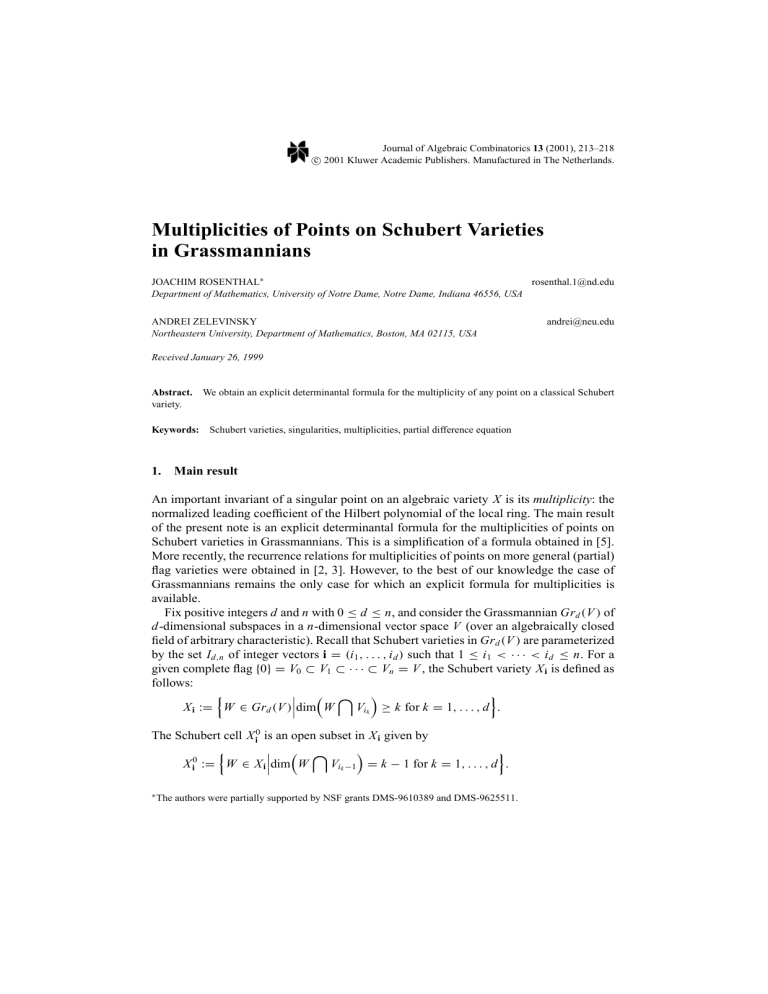
Journal of Algebraic Combinatorics 13 (2001), 213–218
c 2001 Kluwer Academic Publishers. Manufactured in The Netherlands.
°
Multiplicities of Points on Schubert Varieties
in Grassmannians
JOACHIM ROSENTHAL∗
rosenthal.1@nd.edu
Department of Mathematics, University of Notre Dame, Notre Dame, Indiana 46556, USA
ANDREI ZELEVINSKY
Northeastern University, Department of Mathematics, Boston, MA 02115, USA
andrei@neu.edu
Received January 26, 1999
Abstract.
variety.
We obtain an explicit determinantal formula for the multiplicity of any point on a classical Schubert
Keywords: Schubert varieties, singularities, multiplicities, partial difference equation
1.
Main result
An important invariant of a singular point on an algebraic variety X is its multiplicity: the
normalized leading coefficient of the Hilbert polynomial of the local ring. The main result
of the present note is an explicit determinantal formula for the multiplicities of points on
Schubert varieties in Grassmannians. This is a simplification of a formula obtained in [5].
More recently, the recurrence relations for multiplicities of points on more general (partial)
flag varieties were obtained in [2, 3]. However, to the best of our knowledge the case of
Grassmannians remains the only case for which an explicit formula for multiplicities is
available.
Fix positive integers d and n with 0 ≤ d ≤ n, and consider the Grassmannian Grd (V ) of
d-dimensional subspaces in a n-dimensional vector space V (over an algebraically closed
field of arbitrary characteristic). Recall that Schubert varieties in Grd (V ) are parameterized
by the set Id,n of integer vectors i = (i 1 , . . . , i d ) such that 1 ≤ i 1 < · · · < i d ≤ n. For a
given complete flag {0} = V0 ⊂ V1 ⊂ · · · ⊂ Vn = V , the Schubert variety X i is defined as
follows:
¯
n
³ \ ´
o
¯
X i := W ∈ Grd (V )¯dim W
Vik ≥ k for k = 1, . . . , d .
The Schubert cell X i0 is an open subset in X i given by
¯
³ \
n
´
o
¯
Vik −1 = k − 1 for k = 1, . . . , d .
X i0 := W ∈ X i ¯dim W
∗ The
authors were partially supported by NSF grants DMS-9610389 and DMS-9625511.
214
ROSENTHAL AND ZELEVINSKY
It is well known that the Schubert variety X i is the disjoint union of Schubert cells X j0 for
all j ≤ i in the componentwise partial order on Id,n . The multiplicity of a point x in X i is
constant on each Schubert cell X j0 ⊂ X i , and we denote this multiplicity by Mj (i).
Our main result is the following explicit formula for Mj (i) (where the binomial coefficients ( ab ) are subject to the condition that ( ab ) = 0 for b < 0):
Theorem 1 The multiplicity Mj (i) of a point x ∈ X j0 ⊂ X i is given by
³ i1 ´
−s1
³
i1 ´
Mj (i) = (−1)s1 +···+sd det 1 − s1
..
.
³
´
i1
d − 1 − s1
...
...
...
...
...
...
³
³ id ´
−sd
³ id ´
1 − sd
..
.
id
d − 1 − s1
,
´
(1)
where
sq := #{ j p | i q < j p }.
(2)
The proof of Theorem 1 will be given in the next section. Although determinants of
matrices formed by binomial coefficients were extensively studied by combinatorialists
(see, e.g., [1]), the experts whom we consulted did not recognize the determinant in (1).
We conclude this section by an example illustrating Theorem 1.
Example 2 Assume the indices i, j satisfy jd ≤ i 1 . In this situation the numbers s1 , . . . , sd
attain the smallest possible value: s1 = · · · = sd = 0. Then the ( p, q)-entry of the determinant in (1) has the form Pp (i q ), where Pp (t) is a polynomial with the leading term
t p−1 /( p − 1)!. It follows that
Mj (i) =
Y
1
1
(i p − i q ),
V (i) =
1! · · · (d − 1)!
1! · · · (d − 1)! p>q
p−1
where V (i) is the Vandermonde determinant det((i q
2.
)).
Proof of Theorem 1
Fix two vectors j ≤ i from Id,n , and let
deg(j, i) := d − #{i q | i q ∈ { j1 , . . . , jd }}.
For a nonnegative integer vector s = (s1 , . . . , sd ), we set
|s| := s1 + · · · + sd .
(3)
215
MULTIPLICITIES OF POINTS ON SCHUBERT VARIETIES
As shown in [5] and [3, page 202], the multiplicity Mj (i) satisfies the initial condition
Mj (j) = 1 and the partial difference equation
Mj (i) =
X
1
Mj (k),
deg(j, i) k
(4)
.
..
1
..
.
where the sum is over all k ∈ Id,n such that j ≤ k < i, and |k| = |i| − 1.
To prove (1), we proceed by induction on |i|. The initial step is to verify (1) for i = j.
In this case the numbers s1 , . . . , sd attain their maximum possible value: sq = d − q. It
follows that
0 ...
0
1
.
..
1
∗
(5)
(−1)|s| det
= 1 = Mj (j),
..
0
.
∗
...
∗
as required.
For the inductive step, we introduce some notation. To any nonnegative integer vector
s = (s1 , . . . , sd ) we associate a polynomial Ps (t) ∈ Q[t] = Q[t1 , . . . , td ] defined by
³ t1 ´
−s1
³
t1 ´
Ps (t) = (−1)|s| det 1 − s1
..
.
³
´
t1
d − 1 − s1
...
...
...
...
...
...
³
³ td ´
−sd
³ td ´
1 − sd
..
.
td
d − 1 − sd
;
´
(6)
here (st ) is the polynomial t (t − 1) · · · (t − s + 1)/s! for s ≥ 0, and (st ) = 0 for s < 0. Thus
our goal is to show that Mj (i) = Ps (i) with s given by (2).
For q = 1, . . . , d, let 1q : Q[t] → Q[t] denote the partial difference operator 1q P(t) =
P(t) − P(t − eq ), where e1 , . . . , ed are the unit vectors in Qd . Here is the key lemma.
Lemma 3 For any nonnegative integer vector s, the corresponding polynomial Ps (t)
satisfies the partial difference equation
(11 + · · · + 1d )P = 0.
(7)
Q
Proof: First notice that the Vandermonde determinant V (t) = p>q (t p − tq ) satisfies
(7) since it is a non-zero skew-symmetric polynomial of minimal possible degree, and the
operator 11 + · · · + 1d preserves the space of skew-symmetric polynomials. The vector
216
ROSENTHAL AND ZELEVINSKY
space of solutions of (7) is also invariant under translations t 7→ t + k so it is enough to
show that each Ps (t) is a linear combination of polynomials V (t + k). Here is the desired
expression:
µ ¶
µ ¶
X
1
s
s
Ps (t) =
(−1)|k| 1 · · · d V (t + k).
(8)
k1
kd
1! · · · (d − 1)!
0≤k≤s
Let us prove (8). The same argument as in Example 2 above shows that
³
t1 + k1 ´
0
³t + k ´
1
1
1
1
V (t + k) = det
1! · · · (d − 1)!
..
³ . ´
t1 + k1
d −1
...
...
...
...
...
...
³td + kd ´
0
³td + kd ´
.
1
..
.
³td + kd ´
(9)
d −1
Substituting this expression into (8) and performing the multiple summation, we see that
the right hand side becomes the determinant of the d × d matrix whose ( p, q)-entry is
sq
X
(−1)kq
kq =0
¶
µ ¶µ
µ
¶
sq tq + kq
tq
= (−1)sq
kq
p−1
p − 1 − sq
(the last equality is a standard binomial identity). This completes the proof of (8) and Lemma
3.
2
One last piece of preparation before performing the inductive step: the Pascal binomial
t−1
identity (st ) = (t−1
s ) + (s−1) implies that
1q Ps (t) = −Ps+eq (t − eq )
(10)
for any nonnegative integer vector s and any q = 1, . . . , d.
To conclude the proof of Theorem 1, suppose that j < i and assume by induction that
Mj (k) is given by (1) for any k ∈ Id,n such that j ≤ k < i. Let s be the vector given by (2).
In view of (4), the desired equality Mj (i) = Ps (i) is a consequence of the following:
X
Mj (k) = 0,
(11)
deg(j, i)Ps (i) −
k
where the sum is over all k ∈ Id,n such that j ≤ k < i, and |k| = |i| − 1.
We shall deduce (11) from the equality
d
X
q=1
1q Ps (i) = 0
MULTIPLICITIES OF POINTS ON SCHUBERT VARIETIES
217
provided by Lemma 3. To do this, we compute 1q Ps (i) in each of the following mutually
exclusive cases (we use the conventions i 0 = 0 and s0 = d):
/ { j1 , . . . , jd }, i q − 1 > i q−1 . Then k := i − eq belongs to Id,n , and we have
Case 1 i q ∈
j ≤ k. Replacing i by k in (2) does not change the vector s. By our inductive assumption,
Ps (k) = Mj (k), and so 1q Ps (i) = Ps (i) − Mj (k).
/ { j1 , . . . , jd }, i q − 1 = i q−1 . For such q, we have Ps (i − eq ) = 0 since the
Case 2 i q ∈
corresponding determinant has the (q − 1)th and qth columns equal to each other. Thus
1q Ps (i) = Ps (i).
Case 3 i q ∈ { jq+1 , . . . , jd }, i q − 1 > i q−1 . As in Case 1, we have k := i − eq ∈ Id,n , and
j ≤ k. However now replacing i by k in (2) changes s to s + eq . Combining the inductive
assumption with (10), we conclude that 1q Ps (i) = −Ps+eq (k) = −Mj (k).
Case 4 i q ∈ { jq+1 , . . . , jd }, i q − 1 = i q−1 . In this case, the d × d matrix whose determinant is Ps+eq (i − eq ) has the (q − 1)th and qth columns equal to each other, hence
1q Ps (i) = −Ps+eq (k) = 0.
Case 5 i q = jq . Then we have
s1 ≥ s2 ≥ · · · ≥ sq−1 ≥ sq + 1 = d + 1 − q,
and so the d × d matrix whose determinant is Ps+eq (i − eq ) has a zero (d + 1 − q) × q
submatrix. As in Case 4, this implies 1q Ps (i) = −Ps+eq (k) = 0.
Adding up the contributions 1q Ps (i) from all these cases, we obtain (11); this completes
the proof of Theorem 1.
Remark 4
In [5], the multiplicity Mj (i) was expressed as a multiple sum given by (8).
Remark 5 The multiplicity Mj (i) is by definition a positive integer. The partial difference
equation (4) (combined with the initial condition Mj (j) = 1) makes the positivity of Mj (i)
obvious but the fact that Mj (i) is an integer becomes rather mysterious. On the other hand,
Theorem 1 makes it clear that Mj (i) is an integer but not that Mj (i) > 0. It would be
interesting to find an expression for Mj (i) that makes obvious both properties.
Remark 6 The space of all polynomial solutions of the partial difference equation (7)
can be described as follows. Let y = (y1 , . . . , yd ) be an auxiliary set of variables,
Qdand let
n
yq q
ϕ : Q[y] → Q[t] be the isomorphism of vectors spaces that sends each monomial q=1
Qd
to q=1 tq (tq +1) · · · (tq +n q −1). The map ϕ intertwines each 1q with the partial derivative
∂
. It follows that the space of solutions of (7) is the image under ϕ of the Q-subalgebra in
∂ yq
Q[y] generated by all differences y p − yq .
218
ROSENTHAL AND ZELEVINSKY
Remark 7 In the special case when j = (1, 2, . . . , d), the following determinantal
formula for the multiplicity Mj (i) was given in [3]. Let λ be the partition (i d − d, . . . , i 2 −
2, i 1 − 1), and let λ = (α1 , . . . , αr | β1 , . . . , βr ) be the Frobenius notation of λ (see [4]).
According to [3], Mj (i) is equal to the determinant of the r × r matrix whose ( p, q) -entry
q ). It is not immediately clear why this determinantal expression agrees with the one
is (α pα+β
p
given by (1).
Acknowledgments
We are grateful to V. Lakshmibai who initiated this project by suggesting to one of us (J. R.)
to publish the results of his thesis [5]. We thank Sergey Fomin, Ira Gessel and Jerzy Weyman
for helpful conversations.
Added in proof: the questions raised in Remarks 5 and 7 have been resolved by C. Krattenthaler
in his preprint “On multiplicities of points on Schubert varieties in Grassmannians,” arXiv:
math. AG/0011129, November, 2000.
References
1. I. Gessel and G.X. Viennot, “Binomial determinants, paths, and hooklength formulae,” Adv. Math. 58 (1985),
300–321.
2. V. Lakshmibai, “Multiplicities of points on a Schubert variety,” C. R. Acad. Sci. Paris Sér. I Math. 321(2),
(1995), 215–218.
3. V. Lakshmibai and J. Weyman, “Multiplicities of points on a Schubert variety in a minuscule G/P,” Adv. Math.
84 (1990), 179–208.
4. I.G. Macdonald, Symmetric Functions and Hall Polynomials, 2nd edition, Clarendon Press, Oxford, 1995.
5. J. Rosenthal, “Schubertvarietäten und deren Singularitäten,” Diplom Thesis, University of Basel, Switzerland,
1986.
